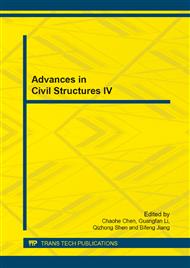p.546
p.550
p.555
p.559
p.568
p.572
p.576
p.580
p.584
Methods for Determination of Residual Mortar Content Adhered to Recycled Aggregate
Abstract:
To study the methods for determination of residual mortar content adhered to recycled aggregate, this paper aims at three methods which are apparent density method, quench hot method and sulfate solution freezing-thawing method. These methods were compared by experiments and their basic principles were also respectively stated. The principles of the latter two methods are similar, which are to separate the residual mortar and aggregate by external factors. But the effects of the sulfate solution freezing-thawing method is better than that of quench hot method. Finally, the best method is chosen to provide some theoretical evidence and research methods in studies and uses of recycled concrete.
Info:
Periodical:
Pages:
568-571
Citation:
Online since:
July 2014
Authors:
Price:
Сopyright:
© 2014 Trans Tech Publications Ltd. All Rights Reserved
Share:
Citation:


